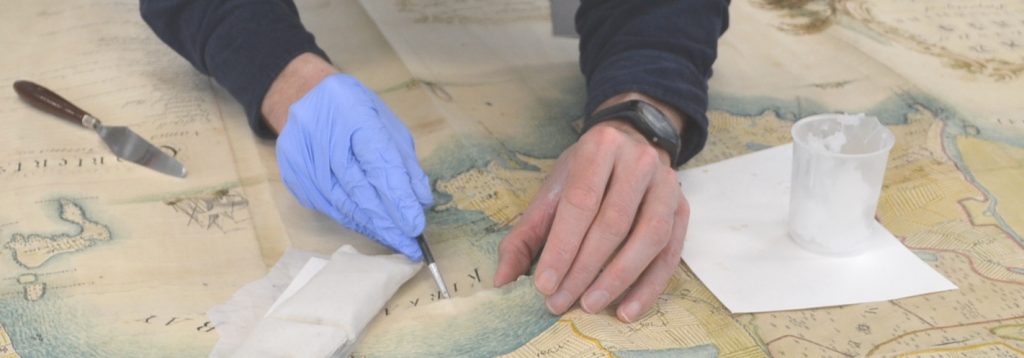 How do I find a conservator?
How do I find a conservator?
Contact your local archive service, museum or art gallery which may have a conservator. Or consult the Conservation Register to find professionals in your area.
What can a conservator do for my documents?
A qualified conservator can clean, repair and package your documents using archival materials and professional techniques. By examining a document, a conservator will also be able to give you some information about its physical make up, e.g. type of paper, ink etc. Different treatment options can be discussed with you depending upon the condition of the item, its future use and importance. You can also be advised about storage and handling.
Where can I buy conservation quality materials for storing my documents?
We have a selection of conservation materials for sale – please email us for further details at [email protected]. Further materials can be purchased from suppliers found on our list. Contact the Conservation Department if you require advice.
Where should I keep my documents?
Keep them somewhere cool, dry, dark and well ventilated. Lofts and basements are not suitable. Fluctuations in temperature and humidity are not recommended, so keep away from radiators or damp walls for example. If you have the means to monitor conditions (environmental monitors are available from conservation suppliers), the ideal temperature is between 16 and 19° C and relative humidity between 45 and 60%.
Do not store on the floor in case of water damage, ingress of dirt, infestation etc.
What should I store my paper documents in?
Primary packaging (i.e. that next to the documents) should be of archival quality. Acidity migrates from poor quality materials. A wide range of materials are available, envelopes, sleeves, boxes etc. These can be tailor-made by a conservator to the size and design appropriate for either single or groups of items, or purchased from conservation suppliers.
Usually, any packaging is better than none at all.
How should I store my photographs?
Photographs like a constant, cool and dry environment. For colour prints in particular, the cooler the better (2°C and 30 – 40% relative humidity). Use a plain album preferably with “unbuffered”, 100% cotton fibre, pH 6, chloride, sulphur and lignin free paper. Mount using photo-corners. Alternatively use envelopes made of the same material or of non-static archival polyester. Treat negatives and prints in the same way.
My book/document is torn, can I mend it?
Do not carry out any repairs yourself, you are likely to do more harm than good. Even using “archival mending tape” can cause irreversible damage if not done properly. If you are not able to get a conservator to repair it for you, support a flat item on a sheet of archival paper and insert into an archival polyester sleeve. A book may require support with a box or wrapping.
What is the best way to frame and display a document/photograph/map?
It is not a good idea to permanently display archival material. Paper is sensitive to fluctuations in temperature and humidity and may cockle, become mouldy or brittle as a result. Also, light will discolour paper and fade pigments and inks. If framing materials are not of the appropriate quality, acidity can migrate into the document over time. It would be preferable to make a good quality duplicate for display.
My documents are mouldy, what should I do?
Firstly, if they are still damp they must be dried out by separating and airing. If they are very fragile, a conservator will need to handle them. Once dry, mould can be dusted off with a very soft brush. Mould spores have health and safety implications so contact with and inhalation of should be avoided. Wear a protective mask and gloves and dust outside if possible. Preferably get a conservator to deal with them for you using the appropriate equipment.
Should I wear gloves when looking through my collection?
There are pros and cons on this issue. Clean cotton gloves protect an item from the acidic and damaging oils on your skin. They demonstrate a conscious effort of care and make one think carefully about how to handle the document in question. Photographs are particularly vulnerable and should always be handled with gloves if possible.
However, regarding paper and books, the fibres in gloves can catch on delicate edges. It can also be difficult to handle items as delicately with a fabric barrier in place. Gloves can also trap dirt and transfer it to other areas of a page or book. If gloves are worn, they should be clean, fit well and used carefully. If not used, hands should be washed and thoroughly dried.
How do I unfold a tightly folded parchment document without damaging it?
Repeated folding and unfolding of any document is not recommended, it weakens the support at the folds and causes abrasion of inks. Preferably, once opened, it should be kept flat or alternatively, copied so that subsequent unfolding is not necessary.
Parchment is often difficult to handle being particularly springy. Ideally a conservator should do this for you. The document should be unfolded in a humid atmosphere if possible, as the parchment will be more flexible. Use weights (make sure they will not damage the surface, wrap in paper or smooth cloth) to hold the document at the edges while you consult it rather than wrestling with it. Take care not to touch inks with your finger, they may be friable.
